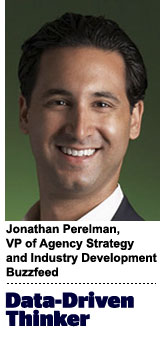 “Data-Driven Thinking” is written by members of the media community and contains fresh ideas on the digital revolution in media.
“Data-Driven Thinking” is written by members of the media community and contains fresh ideas on the digital revolution in media.
Today’s column is written by Jonathan Perelman, vice president of agency strategy and industry development at BuzzFeed.
Bill Gates popularized the phrase “content is king” during a speech in 1996. Although content was king long before then, it has never been more powerful than it is today.
Social networks like Facebook and Twitter have enabled content to be distributed on a massive scale. The evolution from a broadcast-based model to the social-based model of distribution means that anyone with a Facebook or Twitter account can have as big an impact on a piece of content as the evening news once had. The potential for branded content is enormous, but it can only reach its true potential when brands spend as much time understanding distribution across the social Web as they do on the creation.
Twenty years ago, few thought digital media could compete with traditional media. “The truth is no online database will replace your daily newspaper,” stated a Newsweek article in 1995, yet here we are today witnessing the digital revolution change everything. Back then, it was hard to imagine how far digital would evolve and shape the world in which we live today.
While few now debate the power of the Internet as they did in 1995, many still aren’t asking the right questions about how to best use its tools. Good advertising has always been centered on good storytelling. The best ads from the Super Bowl are the ones that make us laugh and cry. As technology has advanced, we’ve started putting more focus and attention on how to buy and sell ads online faster, easier and simpler, but there hasn’t been enough focus on creating relevant digital ads with great storytelling at its core.
Why Distribution Is Queen
The starting point on the Internet for consumers has evolved from portal to search to social. Nearly 80% of millennials sleep with their phone on their nightstand. Nearly all will check their phones before they fall asleep or get out of bed in the morning. And many will even check if they wake up in the middle of the night. The fear of missing out (FOMO) is real and it’s fundamental to understand how content spreads.
Think about the first thing you do when you wake up and grab your mobile. I doubt any of us are thinking, “What should I search for?” Instead, we’re interested in finding out what our friends are up to, what is happening around the world or in our backyard, and sharing our own updates. No one wakes up in the morning and thinks, “I need to see what basset hounds running look like,” but when your friend posts it to Facebook, you can’t help but smile.
Be it basset hounds running or breaking news, the power of the social Web isn’t in the platforms — it’s in the content that travels across them. In the early days of the social Web, your identity was based on what you said or wrote about yourself in your profile. Today, the content you share, such as tweets, says more about you than what you write about yourself. This allows brands to not just have a voice, but also add significant value to the user experience.
How The Queen Completes The King
Consumers welcome brands becoming publishers. Look at some of the world’s biggest brands: Coke has 75 million Facebook fans, Starbucks has 35 million and Pepsi has 28 million. Consumers are not only receptive to what the brands have to say, but they actively seek it out. However, simply creating high-quality or really good content isn’t enough. That’s important, even vital, but it’s just the first step.
Let’s start with the understanding that content only has the ability to be shared if, and only if, it’s good. There is a lot of great content that isn’t seen by anyone. Understanding how the content will travel and share across the Web is just as important as what the content is.
Social media may be a new phenomenon, but social networks have been around since human beings first inhabited the earth. From the earliest cave drawings dating back 40,000 years to a group of people gathering at a bar to watch their favorite sports team, humans have always been social creatures. People have always wanted to be entertained.
Today, advertising can tell an engaging story that adds to the experience, not distracts from it. Today’s technology and social networks allow for word-of mouth marketing to occur at Internet scale.
Follow Jonathan Perelman (@JPerelman), his socks (@JPerelman_Socks), BuzzFeed (@BuzzFeed) and AdExchanger (@adexchanger) on Twitter.












